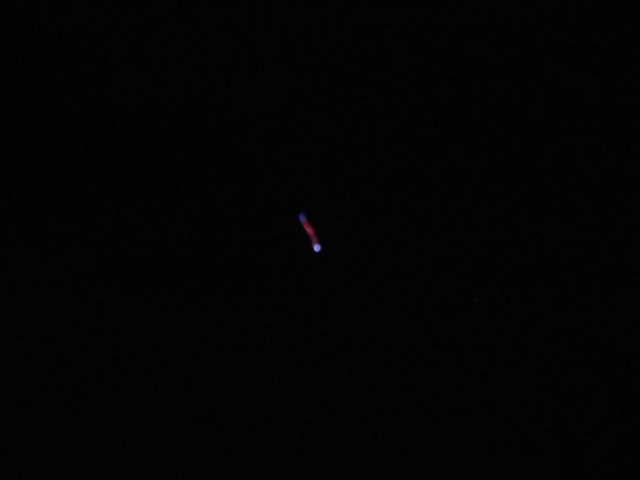This may be Betelgeuse. I have not checked with a sky atlas of what is visible currently. It was the brightest star in the pre-dawn sky this morning at 03:58:26 AM. It was toward the southeast.
At first I thought it was an approaching airplane. I quickly ruled that out because landing lights do not show strong color fluctuations.
I started to zoom to make the image appear larger. (It was not a point image, due to atmospheric turbulence and scattering, etc.) I did zoom to 88.7mm. The max is 247mm with the Canon SX60 HS camera's zoom lens.
It was getting tricky to hold the star's image steady. My tripod is malfunctioning. One leg will not extend. (:-) (Later repaired)
I could have changed the mode to exposure time control at a larger ISO number to freeze the motion. Or, I could have leaned agains a fence to steady the image and zoomed out further.
Then I remembered the first spectral streak cameras at Avco Everett Research Lab, at the beginning of our reentry physics studies.
I realized that, while I had no diffraction grating, a star moving across the focal plane as it varied in color would clearly show the strong color variations I was observing.
_________________
Why do Stars Twinkle and Planets Don’t?
With three bright planets visible every evening nowadays, it’s a great time to review why stars twinkle and planets generally do not.
You’ve heard about the speed of light being the fastest possible speed allowed by physics, but that maximum speed is only achievable when light travels in a vacuum — like outer space. Any time light is travelling through a transparent substance, its speed is reduced. I won’t go into the details, but suffice to say that air slows it down a little, and substances like glass, diamond, and water slow it much more.
Furthermore, whenever a ray of light passes from one medium into another at an oblique angle, its direction is altered, too — like when your car’s wheels hit a soft shoulder and the car is pulled off the road. Lenses are carefully shaped so that light passing through the centre isn’t altered, but light passing through the portions between the centre and the edge are bent in a systematic way that focuses the light.
There are two more pieces to this puzzle. Firstly, the amount that light rays are bent depends on the wavelength, or colour, of the light. That’s why a prism of heavy glass is able to create a rainbow out of a ray of white sunlight. It’s also why poor quality telescope lenses create images with fringes of colour around bright objects. Better telescopes use special glass, and sandwiched lens designs, to bend all colours as equally as possible.
Secondly, the effect on starlight is proportional to the amount of air it passes through. When the light from a star that is straight overhead enters our atmosphere, it does so at a steep angle (i.e., almost no tilt with the top of the atmosphere), and it travels through the minimum amount of air. Light from objects that are lower in the sky is entering at an angle and travelling through a thicker blanket of air. Light from objects near the horizon are passing through nearly twice as much air, and they are entering at a very shallow angle indeed.
So what does this mean?
The twinkling of celestial objects is related to the shimmering you see over a hot highway. The air between you and objects in the distance is extra turbulent because of the heated road surface, and the light rays from those objects are jostled and disrupted by the little cells of heated air that act like tiny dancing magnifying glasses. Similarly, the light from a distant star you see in the night sky has to traverse our atmosphere before arriving at your eyes. If there is turbulence in that air, the object will appear unsteady, both to unaided eyes, and in a telescope.
Stars are so far away that they appear to us as point sources of light — like a VERY thin laser beam. It’s very easy for all, or most, of a narrow beam of starlight to be diverted or focused by one of those virtual little dancing magnifying air pockets. As the air moves around, you might get some extra light one moment, and nearly none the next. The result is a random change in intensity, or twinkling, of the starlight. Because starlight, like sunlight, is composed of many colours merged together, the atmosphere can also bend the light and separate the colours. This is why a bright star such as Sirius, which never gets too high in the sky for northerners, exhibits legendary flashes of intense colour while it twinkles.
On nights when the air is very calm, or is flowing smoothly overhead, it is very homogeneous, and we see very stable stars with next to no twinkling. The world’s largest observatories are located where the air is normally smooth and steady (and at higher elevation so there’s less of it).
One last thing. Planets, even distant ones like Uranus and Neptune, reflect the Sun’s light back to us with a substantially thicker light beam than starlight. The thicker beam is wide compared to our atmosphere’s little turbulence cells, so we see planets shining with a steady light — except under very rough air conditions. Nevertheless, if you look at a planet through your telescope when it is near the horizon, all that extra air WILL cause it to look blurry, and the colours can come apart, too. That’s why astronomers and planetary photographers work out when the planets are highest in the sky, and look at them then. Unfortunately, the summertime Ecliptic never gets very high in the sky, so summer planets hug the horizon, for less than perfect viewing.
Stargazing News by Chris Vaughan
 new
new

